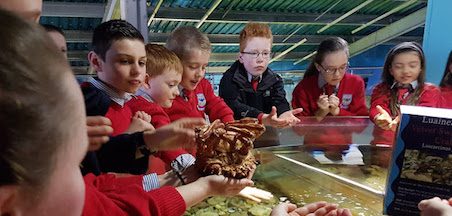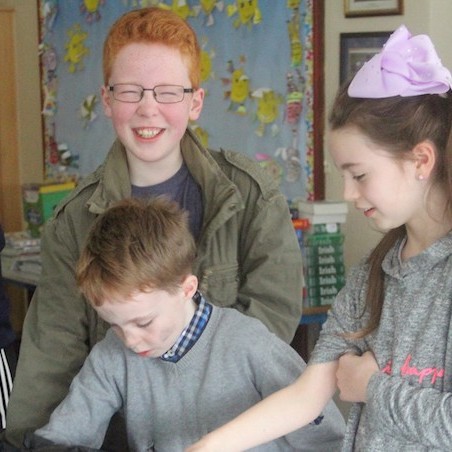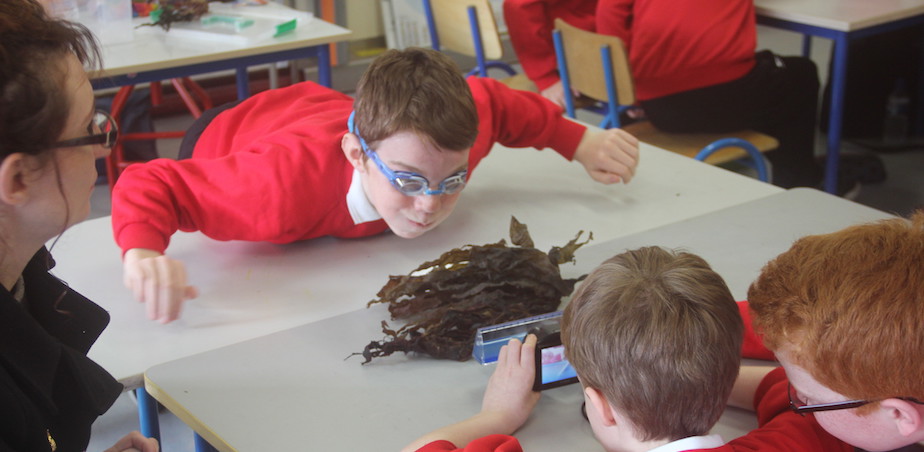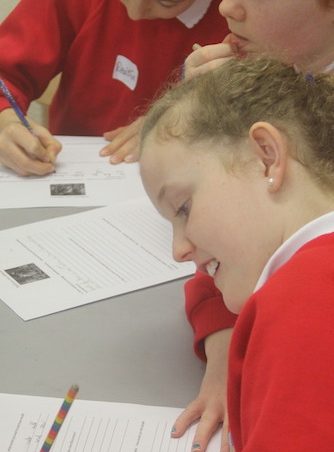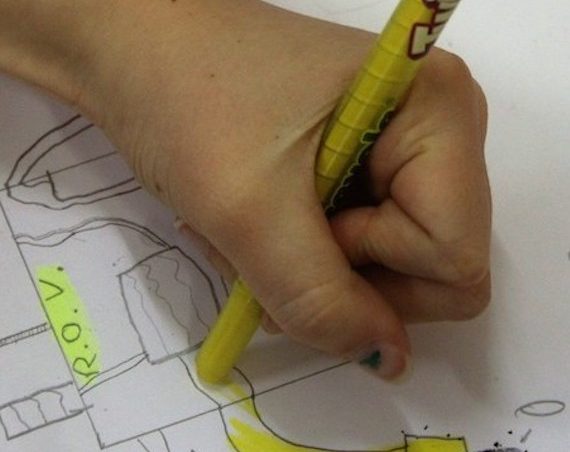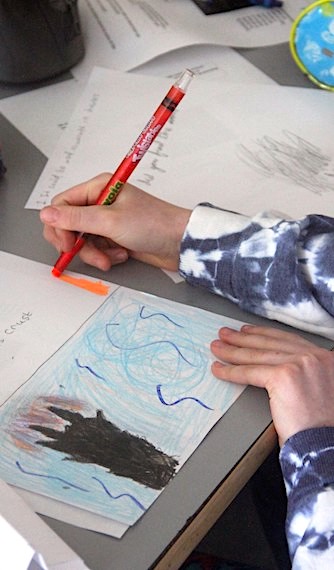Refine by Region
Refine by Art Form
Refine by School Level
Build Your Own Unknown
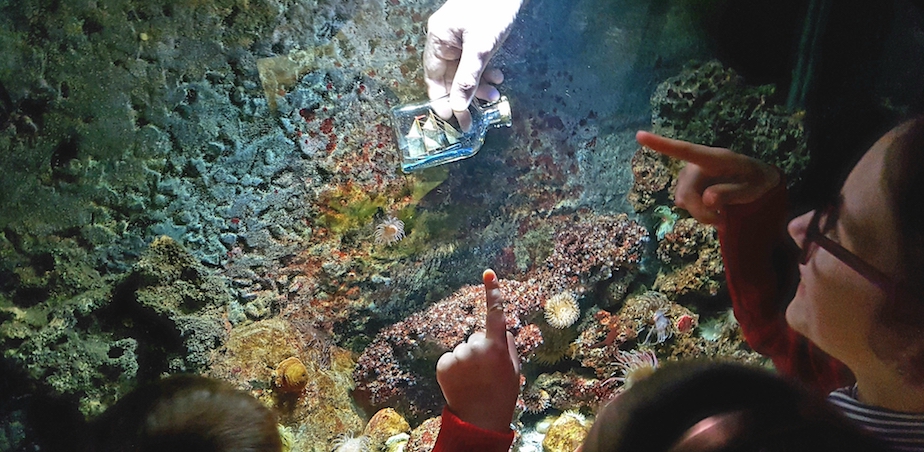
Artist Louise Manifold, 4th Class from Cregmore National School and their teacher Stephanie Herwood, commissioned by TULCA and funded by the Marine Institute.
“Build Your Own Unknown” is a collaboration between Artist Louise Manifold, Cregmore NS and TULCA partnering with The Marine Institute.
Tell us the story of your project – What was the impetus? What was it about? Who was involved? How did you begin?
Joanna McGlynn, Education Coordinator / Project Developer, TULCA
TULCA OFFshore is a unique collaborative project whereby students, teacher, artist and scientist, learn and work together in the classroom as co-creators and collaborators. At the core of the project is engaging with and understanding the essential principles and fundamental concepts of ocean science literacy in a meaningful way, through the Arts. Beyond a wide range of materials, practices, histories and techniques, concepts and theoretical frameworks, artists – like scientists – are trained to use a unique set of skills, processes and methodologies. Learning through the Arts, is the essential ‘other’ of STEM education, in developing a unique set of holistic skills, transferable across multiple sectors in preparation for adult life. Young students will have the opportunity to connect STEM skills through core processes of interpretation, communication, analysis and synthesis, resulting in a broader awareness of complex ocean issues and its relevance in our everyday. TULCA and the Marine Institute are uniquely positioned to provide collaborations between some of Ireland’s leading artists and marine scientists, creating a platform of connection and interdisciplinary reach in an educational environment. For this pilot project, TULCA are delighted to partner artist Louise Manifold and scientist Dr. Andy Wheeler with Cregmore National School, Co. Galway. The project began in February 2017 and will run until July with 10 in school working sessions culminating in a public exhibition at SeaFest 2017. This Project/Partnership represents the process to date.
Louise Manifold, Artist
Build Your Own Unknown was developed in response to TULCA’s OFFshore proposal to create an art project with 4th class, Cregmore National School that responded to the recent discovery of a field of hydrothermal vents along the Mid-Atlantic Ridge during a research voyage led by Dr Andy Wheeler on the Celtic Explorer. In response to the call, I proposed to develop a series of workshops that will result in the production of a mini sci-fi film, in which students will work together to design, build and create their own sci-fi narrative reenacting the discovery of Moytirra – the name of the ridge of hydrothermal vents.
Stephanie Herwood, Teacher
Myself and my class were approached last year to see if we were interested in a new film project. The film project was of huge interest to us because I believe film and animation are a brilliant and innovative new way to encourage children to communicate stories, ideas and concepts in a creative and original way. The class have experience producing a film, when they created an animation film on ‘The Miracle of Milk’ in October 2016. The production of the film gave the class a taste for film making and the processes involved. When we heard the theme of the project was the Moytirra discovery, we knew straight away it was going to be a very exciting adventure. Water is such a big part of our lives here in Galway and this project is only one of many water projects the school have engaged in. ‘Something Fishy’ is another project the class are working on and this has introduced the class to The Lifecycle of the Salmon and Water all around the World. The two projects have complemented each other nicely and gave the children a good foundation before embarking on Build your own Unknown. Myself and the class had an opportunity to meet Louise Manifold and Joanna McGlynn and straight away the class warmed to the two ladies and a rapport was established. Louise introduced us to some of her work and her earlier projects. We sat down together and decided on a timetable and a schedule so we could get started on the project.
How were the ideas developed and how did the young people, artist and teacher work together?
Joanna McGlynn
In developing a project like this, it is essential to recognise all collaborators as experts in their own fields, with each contributing resources for the generation of new ideas in the classroom thus recognising the children as authors of their own imaginations. In support of this cross-disciplinary process a definite structure was put in place to include four phases; research and development, engagement, final production and installation /exhibition. Artist, teacher and student participate collectively in realising each project phase. Having passed through the R & D phase, the project is now in the exciting process of hands on making.
Louise Manifold
One of the central themes within my artistic practice explores how society uses fiction in order to understand fact. The result of this exploration has developed into a process I frequently use to work with ideas in educational contexts. I am fascinated by the relationship between science and cinema, with particular reference to how scientific discoveries, that are beyond human encounter, have been retold in early sci-fi film. Considering this, the project takes reference from one of the earliest science fiction films: Le Voyage Dans La Lune (A Trip to the Moon) (1902) created by turn-of-the-century French filmmaker Georges Méliès. Drawing from this genre and linking it to the popular DIY science projects (such as miniature erupting volcanoes), the project titled Build Your Own Unknown asks the students to work collectively to create a deep-sea ecosystem film set for their own sci-fi film production. It will work with early cinematic techniques of stop motion animation and compositing as a means to reinterpret marine science discovery into cultural forms of storytelling, sculptural and role play. Students are working in four teams and have been asked to develop their set designs in response to a number of real and imaginary sources to include: actual digital film footage of the vent field sourced from the ROV Holland research expedition; interviews with real scientist such as Dr Andrew Wheeler and Rosemarie Butler (vessels operator at the MI); sensory and embodied exercises; investigating the creatures that live there and the Irish mythology of Moytirra. The students will also get to work with Galway Atlantaquaria, to develop underwater aspects of the film and to document deep sea environments for underwater scenes and sonic recordings as part of the creation of a surreal underwater landscapes. Students are encouraged to work together using a number of resources and strategies to solve problems. In this way the project aims to emphasise collaborative learning and to create a sense of ownership on how the work will be delivered as an outcome.
Stephanie Herwood
Our first step in the project was research. We learned as much as we could about the ‘Moytirra’ discovery, the field of Hydrothermal vents along the Mid Atlantic Ridge, The Celtic Explorer and Dr. Andy Wheeler. During our early sessions with Louise Manifold and Joanna McGlynn, the children discovered all the main facts and details about the discovery. The visits involved dividing children into groups and sharing their ideas and facts in a group setting. Based on the facts learned children engaged in creative writing lessons, drama activities and art classes. The early lessons shaped and refined their knowledge and understanding. We also had the opportunity to experience sea life first hand when a skype call was organised with Louise on board the Celtic Explorer. Prior to the call the children engaged in brainstorming activities within their groups on appropriate questions to ask Louise. This call gave children a real feel for life on board the ship and it was definitely a highlight of the project to date. In the later sessions the children started building their sets in their groups and creating story boards for their film. The class also had the opportunity to film in the Galway Aquarium in a selected number of tanks using go pros. Groups also started recording sounds in the Aquarium which will be used throughout the project. All of the lessons have been very well structured with clear objectives and learning outcomes set out in every time slot.
What was your personal experience of the project in terms of successes and challenges?
Stephanie Herwood
Collaborative work in the classroom has huge benefits which range from building self esteem, developing oral communication skills, enhancing student satisfaction and the learning experience and above all it retains the children’s attention in the classroom. One huge success of this project will include the ability to share the knowledge and findings easily with their peers in the school and the world. I believe this will be a fantastic starting point for building up ties and a sense of community across borders with students around the world. The whole school are behind the class and are very excited to see the final film. The class have also gained huge experience using equipment they have not worked with before e.g. go pro cameras and hand-held recording devices. This project also provides an exciting and dynamic platform to learn about a new topic. Students are engaging with new and exciting people, which are exposing them to new knowledge and new pathways in life. Since this project started many members of the class have expressed an interest in becoming a Marine Scientist, an Artist, an Explorer etc. The main challenge I have encountered in the class is time. I would love to dedicate more time to this project but unfortunately there is a very large curriculum of work to cover so three hours a week will have to suffice for now.
Louise Manifold
The project so far has been extremely successful. I feel there is a very strong connection and support network between all the partners involved in the project. The children have responded well to multiple sources of information in developing their project ideas. Initially I was concerned that the length of our workshop time might be a challenge however this is not the case. We work 3 hours in the classroom a week per session – 1.5 hours would be a typical session time of previous projects I worked on with young students. So far this added durational aspect has provided an opportunity for more student led direction into the nature of the research, including devising their own sets of questions to interview Dr. Andy Wheeler directly. It also adds to the project’s momentum providing an opportunity for a deeper engagement with both artistic and scientific enquiry and importantly really helps my role and relationship in the class as I got to know the group much quicker.
What was significant for you about the project that is worth sharing?
Joanna McGlynn
As the project is mid process, it is only beginning to reveal itself but I am excited by the possibility of working through a collaborative approach. Linking technology into the project and creating unique opportunities such as a live SKYPE to Louise on board the Celtic Explorer from the classroom and filming off-site using GoPro camera, outside of the school environment have injected an excitable energy of discovery into the project. TULCA propose to co-develop a set of cross disciplinary lesson plans informed by this process which will be made available online through the Explorers Education Programme™, extending the legacy of this unique project into other schools and classrooms nationwide.
Louise Manifold
What makes the project significant to me is the sense of creative possibility. I feel the number of stakeholders in the project allow for a greater diversity of input and contribute to this sense of possibility. There is a very strong support network between both TULCA and the school, which has really encouraged the ambition of the project’s development. It is also a really interesting subject to respond to as an artist.
Stephanie Herwood
The most significant thing about the project I think that is worth sharing is the joy that the class are experiencing during this project. No two days have been the same and the class are completely and utterly absorbed in the information and lessons. I was always a huge believer in collaborative learning but this project has reinforced the huge advantages that can be seen in group work. I also believe that all students should learn about the new world that has been discovered deep under the ocean. I had not heard about the discovery before I was introduced to the project and I would love the findings to be shared with as many people around the world.
Has anything changed in your work as a result of the project?
Louise Manifold
In respect to where we are right now in the project I would have to say that I am still understanding the value of the work. I can say so far it has given me a deep awareness on the value of creativity as a means for young children to understand often complex scientific discoveries and the use of art process as a means to think through and invite curiosity on environments that are inaccessible to us.
Stephanie Herwood
This project has opened up my ideas on art lessons within the class. Louise has introduced us to so many materials which I have never worked with before e.g. plaster of paris and chicken wire. This project has given me the confidence to expand my ideas when it comes to art and themes within the class. We have also engaged in more Skype calls since the beginning of the project. Skype has allowed us to connect with experts in so many different fields and the children are constantly coming up with new people to contact and learn about. This will definitely be a tool I will use more of in the future.
Spotlight
Artist(s):
Louise Manifold
“I am an interdisciplinary artist working primarily in moving image,which I believe to be a wholly collaborative medium. One of the key elements in my own process is the idea of thinking through making, what we can learn through physically creating art works; sometimes it is gaining new knowledge on how to work together, sometimes it is that art provides a space for curiosity. I believe artists are as keen to find out out about the world as scientist, it is just different forms of observation.”
Louise Manifold studied at Central St Martins College London and G.M.I.T Galway. She has exhibited extensively throughout Ireland and internationally and has been the recipient of awards from The Arts Council of Ireland, Culture Ireland, and local authorities. In 2009 she was one of the four artists short-listed for the AIB Art prize. Louise has worked with Galway Arts Center Red Bird Youth Collective, Create, Galway Film Center, Helium Arts Trust and Galway County Council Artists in Schools Scheme.
Recent projects include commissioned work for Winter Pages edit by Kevin and Olivia Barry, Berlin open studios, Wild-Screen 2015 and Trauma at the Science Gallery, Dublin.
In 2017 she will begin a three year project entitled AerialSparks! an interdisciplinary radio art project that explores radio’s relationship to the unknown. AerialSparks! is being produced for Galway 2020 in collaboration with the Marine Institute Galway and co funded by the Arts Council of Ireland project awards 2017.
Teacher(s):
Stephanie Herwood
My name is Stephanie Herwood, I've been teaching for ten years. I have a background in IT and I believe it was this platform that gave me the love and appreciation for collaborative work. I worked for an IT company called PlanNet21 which involved huge collaboration from many different teams to complete projects and reach deadlines.
Our class has completed several formal and informal collaborative projects in the classroom this year which include a ReelLIFE SCIENCE animation film. In this project children worked together to research an idea, create a storyboard, design backdrops, create props, capture an animation and edit their final video ( https://www.youtube.com/watch?v=9-hO6SG3sm0 ).
Last year I made an animation with my class and it won the educational award in the Fís Film Festival
( https://www.youtube.com/watch?v=G7ClFwIKOms ).
Our class have also successfully completed Scratch projects, where they had to work together to complete a quiz by coding their steps in a programme called Scratch. The projects were entered in the National Scratch competition and can be found here ( https://scratch.mit.edu/users/steherwood ).
The class have also worked on a number of informal collaborative projects which range from creative writing to Powerpoint.
Other:
(Curator, agency, etc):
Joanna McGlynn / TULCA
Joanna McGlynn is an arts educator and a socially engaged arts practitioner based in Galway, Ireland. She holds a first class honours Masters in Social Practice and the Creative Environment from Limerick School of Art and Design (2016) and a Degree in Fine and Applied Art from the University of Ulster, Belfast (2002).
Since 2013, she has held the position of Education Coordinator for TULCA Festival of Visual Arts responsible for the design and implementation of T.Ed, a unique education programme designed to increase participation in and a shared understanding of contemporary visual arts.
TULCA is a visual arts organisations based in the west of Ireland who commission, produce and programme contemporary art. TULCA has a reputation for collaborating and delivering innovative programming in visual culture, working across all art forms bringing cultural experiences to its audiences.

Artist(s)
Louise Manifold
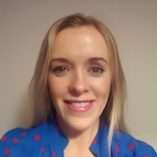
Teacher(s)
Stephanie Herwood
Artforms
School Level
School/
Participant Group
Gregmore NS, Claregalway, Co. Galway
No. Participants
19
Region
Age/Class
4th Class
Dates
February - July 2017
Weblinks
Curriculum Strands
Visual Arts; Science - ocean literacy ; Geography - oceans shape our earth, natural environments; English - oral language, creative writing; Maths; History - Irish Mythology
Research or relevant publications
I can say so far it has given me a deep awareness on the value of creativity as a means for young children to understand often complex scientific discoveries and the use of art process as a means to think through and invite curiosity on environments that are inaccessible to us.
Artist, Louise Manifold
